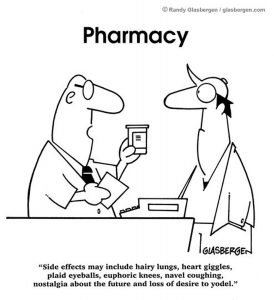When Are Antibiotics Appropriate and When Should I Avoid Using Them?
 People are becoming increasingly aware of the dangers that can result from the overuse of antibiotics. When antibiotics were first discovered in the early 20th century, researchers believed that they had found the key to conquering many deadly diseases. Since that time, antibiotics have certainly helped to cure diseases that once wiped out large parts of the population. However, there is growing evidence that antibiotics are now being used too frequently, and that they are often being used in inappropriate circumstances. This has led to many previously curable diseases becoming antibiotic-resistant, which means that a cure now requires the use far stronger antibiotics. In fact, some diseases have now become resistant to nearly all antibiotics. It is obvious that if antibiotic use continues in this way, we may have a major health crisis on our hands.
People are becoming increasingly aware of the dangers that can result from the overuse of antibiotics. When antibiotics were first discovered in the early 20th century, researchers believed that they had found the key to conquering many deadly diseases. Since that time, antibiotics have certainly helped to cure diseases that once wiped out large parts of the population. However, there is growing evidence that antibiotics are now being used too frequently, and that they are often being used in inappropriate circumstances. This has led to many previously curable diseases becoming antibiotic-resistant, which means that a cure now requires the use far stronger antibiotics. In fact, some diseases have now become resistant to nearly all antibiotics. It is obvious that if antibiotic use continues in this way, we may have a major health crisis on our hands.
The first thing to be aware of is that antibiotics are not effective in the treatment of viruses. They only treat bacterial infections, certain fungal infections and parasites. For diseases such as the common cold, flu or bronchitis, antibiotics are completely ineffective and their use in cases such as these will only contribute to the development of antibiotic-resistant bacteria. You should not ask your doctor to prescribe antibiotics if you have a sore throat or the stomach flu, for instance. According to the Centers for Disease Control and Prevention (CDC), antibiotics were prescribed for an acute respiratory infection in 68% of visits to the doctor. However, 80% of those prescriptions were unnecessary.
Antibiotics are often an appropriate treatment for conditions such as severe sinus infections that last longer than two weeks, ear infections, bladder infections and skin infections. These are frequently due to a bacterial or fungal infection, and treating them with antibiotics is effective.
If you have been prescribed an antibiotic, it is very important that you take it exactly as directed by your physician. If your symptoms happen to clear up before the entire course of antibiotics is completed, you must still continue to take them as prescribed. This is because there may still be a few lingering bacteria in your system, and—if they are not all killed—the strongest ones may survive to produce new generations of ever stronger bacteria that might make current antibiotics less effective.
Some doctors feel pressured by their patients to prescribe something, whether it’s really going to be helpful or not. A study published in the journal Pediatrics found that pediatricians will prescribe antibiotics for children 62% of the time if parents expect them to, and only 7% of the time if the parents do not expect an antibiotic prescription. Do not put pressure on your doctor to prescribe antibiotics for your condition. He or she is the best judge as to whether antibiotics are appropriate.
Also remember…you can boost your immune system and those of your family if you get adjusted! Call our office at 406-652-3553 if you would like an adjustment!
 If you are like most people, working out just for the sake of working out does not really appeal (although there are many dedicated gym buffs who couldn’t live without their daily workouts!). We all know that it’s important to exercise regularly if we want to live a long and healthy life. However, if you find the idea of trotting along on a treadmill for 15 minutes and then spending half an hour of working out on Nautilus machines to be about as exciting as a trip to the dentist, then this article is for you!
If you are like most people, working out just for the sake of working out does not really appeal (although there are many dedicated gym buffs who couldn’t live without their daily workouts!). We all know that it’s important to exercise regularly if we want to live a long and healthy life. However, if you find the idea of trotting along on a treadmill for 15 minutes and then spending half an hour of working out on Nautilus machines to be about as exciting as a trip to the dentist, then this article is for you! Many studies have found that chiropractic care is a safe and effective treatment method when dealing with a number of spine-related issues. The American Chiropractic Association even lists a number of research studies on their website that show that it is a valuable treatment method for easing (and sometimes completely resolving) back pain, neck pain, headaches, and more.
Many studies have found that chiropractic care is a safe and effective treatment method when dealing with a number of spine-related issues. The American Chiropractic Association even lists a number of research studies on their website that show that it is a valuable treatment method for easing (and sometimes completely resolving) back pain, neck pain, headaches, and more. Tension and cervicogenic headaches are clinically similar, but they are associated with varying personality traits. A recent
Tension and cervicogenic headaches are clinically similar, but they are associated with varying personality traits. A recent  We all know physical activity can do wonders for lifting the mood, but new research shows that regular exercise may actually prevent the onset of depression.
We all know physical activity can do wonders for lifting the mood, but new research shows that regular exercise may actually prevent the onset of depression. People are becoming increasingly aware of the dangers that can result from the overuse of antibiotics. When antibiotics were first discovered in the early 20th century, researchers believed that they had found the key to conquering many deadly diseases. Since that time, antibiotics have certainly helped to cure diseases that once wiped out large parts of the population. However, there is growing evidence that antibiotics are now being used too frequently, and that they are often being used in inappropriate circumstances. This has led to many previously curable diseases becoming antibiotic-resistant, which means that a cure now requires the use far stronger antibiotics. In fact, some diseases have now become resistant to nearly all antibiotics. It is obvious that if antibiotic use continues in this way, we may have a major health crisis on our hands.
People are becoming increasingly aware of the dangers that can result from the overuse of antibiotics. When antibiotics were first discovered in the early 20th century, researchers believed that they had found the key to conquering many deadly diseases. Since that time, antibiotics have certainly helped to cure diseases that once wiped out large parts of the population. However, there is growing evidence that antibiotics are now being used too frequently, and that they are often being used in inappropriate circumstances. This has led to many previously curable diseases becoming antibiotic-resistant, which means that a cure now requires the use far stronger antibiotics. In fact, some diseases have now become resistant to nearly all antibiotics. It is obvious that if antibiotic use continues in this way, we may have a major health crisis on our hands. With headaches being one of the most common nervous system disorders worldwide, affecting almost 50 percent of the population at least once annually, finding a way to relieve them is important to when it comes to improving quality of life for a large number of people. Certainly there are several different types of headaches–migraines, cluster headaches, and medication-overuse headaches, for instance–and each one requires a unique approach for treatment.
With headaches being one of the most common nervous system disorders worldwide, affecting almost 50 percent of the population at least once annually, finding a way to relieve them is important to when it comes to improving quality of life for a large number of people. Certainly there are several different types of headaches–migraines, cluster headaches, and medication-overuse headaches, for instance–and each one requires a unique approach for treatment. Sciatica pain is often so debilitating that it forces people to miss work and other normal activities. Of all patients with low-back pain, sciatica patients have the highest level of disability (1). In fact, patients with sciatica are disabled for an average of 72 days according to Norwegian public-health records.
Sciatica pain is often so debilitating that it forces people to miss work and other normal activities. Of all patients with low-back pain, sciatica patients have the highest level of disability (1). In fact, patients with sciatica are disabled for an average of 72 days according to Norwegian public-health records. Back pain is an expensive health problem for both patients and businesses.
Back pain is an expensive health problem for both patients and businesses. 